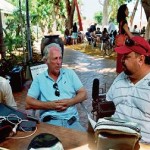On Location: Bran Nue Dae
 Even before it became a stage hit, Bran Nue Dae seemed destined for success. Peter Galvin reports from Broome, Western Australia.
Even before it became a stage hit, Bran Nue Dae seemed destined for success. Peter Galvin reports from Broome, Western Australia.
Producer Robyn Kershaw (Looking For Alibrandi) knew the story’s potential ever since the first workshop, when she was a part of the West Australian Theatre Company, in 1987.“It was a wonderful discovery…you’re just so full of life after seeing the play, people were bouncing in their seats and the WATC jumped on it and produced it. The play ended up premiering at the Perth festival in 1990,” she recalls.
Bran Nue Dae then toured the east coast and more than 200,000 people saw it: “That was a fantastic result for a stage show,” adds Graeme Isaac (Dhakiyarr vs. The King), who is producing the film adaptation with Kershaw. Director Rachel Perkins (First Australians) is sharing the screenplay credit with Reg Cribb (Last Train to Freo).
Perkins describes it as a “rites of passage” film. “It’s about a young guy, Willie (Rocky Mckenzie, from Broome, in his acting debut), who has to stand up and choose his own way forward in life, and about the people he meets on his journey who enable him to do that.” According to Isaac, the stage play – which draws heavily on the missionary past of Broome – was more like a revue in form: “It was accessible and irreverent, and it had the feeling of coming from a real time and place while having a strong sensuality.” Bran Nue Dae “sent up everyone” Issac says, “black and white, the Church, etc., and the lyrics were playful.”
“There’s nothing I would rather be, than to be an Aborigine,” one character sings. The screenplay, says Isaac, is taut but it keeps the “joyous, free-wheeling atmosphere” of a show where, in the end, everyone is forgiven. Other key cast includes Geoffrey Rush, Ernie
Dingo, Magda Szubanski, Deborah Mailman and Tom Budge.
The producers and director all have a long relationship with the author of the stage show, Jimmy Chi, and the band with which he composed the music, The Kuckles. Isaac met Chi around 1980, back when the Broome-born songwriter was talking about making a movie out of the story told in the songs. A number of earlier attempts to produce a film stalled; Issac acquired the screen rights originally nearly a decade ago, only to have them lapse and then renewed. For a while, when Kershaw was head of TV drama at the ABC, the Perkins/Issac team looked at the possibility of a telemovie. “That ABC involvement, in terms of a license fee, ended up triggering the money for a theatrical feature,” Kershaw says.
The film was finally financed though Screen Australia, Omnilab Media, ABC, ScreenWest, Film Victoria, and the Melbourne International Film Festival Premiere Fund.

